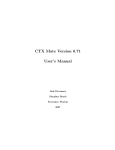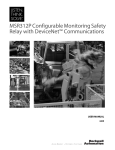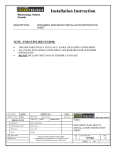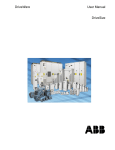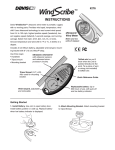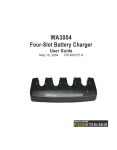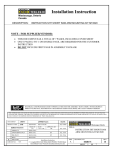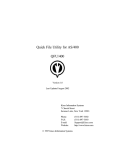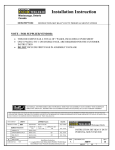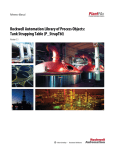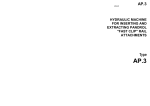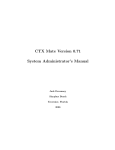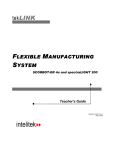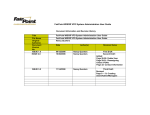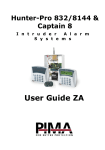Download 807-General-Manual_Jan-2012
Transcript
INSTRUCTION MANUAL FTLG 807 marine level gauges Work address: Mail address: Henri Systems Holland B.V. Scheepmakersstraat 33 3334 KG Zwijndrecht Netherlands Tel: +31 (0)78 6100999 Fax: +31 (0)78 6103214 Henri Systems Holland B.V. P.O.Box 198 3330 AD Zwijndrecht Netherlands E-mail: [email protected] www.hsh.nl ©Henri Systems Holland B.V. USER MANUAL FTLG 807 (0112) Contents 1 INTRODUCTION ..........................................................................................................................4 1.1 1.2 1.3 2 MOUNTING .................................................................................................................................8 2.1 2.2 3 MOUNTING OF LEVEL GAUGES, GENERAL ........................................................................................ 8 LIQUEFIED GAS TANKERS ............................................................................................................ 8 COMMISSIONING........................................................................................................................9 3.1 3.2 3.3 3.4 3.5 3.6 3.7 3.8 3.9 4 LEVEL GAUGE CONSTRUCTION AND WORKING PRINCIPLE..................................................................... 5 LEVEL GAUGE IDENTIFICATION CODE ............................................................................................. 6 ACCURACY ............................................................................................................................. 7 SPRING MOTOR ADJUSTMENT...................................................................................................... 9 LOCAL LEVEL INDICATOR SETTING ................................................................................................. 9 REFERENCE SWITCH AND LEVEL ALARM SWITCH (IF FITTED) ................................................................. 9 SWITCH OPERATION................................................................................................................ 10 SWITCH SETTING .................................................................................................................... 10 LEVEL TRANSMITTER (IF FITTED) ................................................................................................. 11 OIL FILLING ........................................................................................................................... 11 STARTING-UP ........................................................................................................................ 11 RECOMMENDED OILS FOR LEVEL GAUGES ..................................................................................... 12 OPERATION............................................................................................................................... 13 4.1 OPERATION WITH MANUAL FLOAT HOISTING MECHANISM ................................................................ 13 5 MAINTENANCE ......................................................................................................................... 13 6 TROUBLE SHOOTING ................................................................................................................. 14 7 PARTS LIST 807 SERIES MARINE LEVEL GAUGES ........................................................................ 15 7.1 7.2 7.3 RECOMMENDED SPARE PARTS FOR LEVEL GAUGES .......................................................................... 17 HOW TO ORDER SPARE PARTS.................................................................................................... 17 TOOLS................................................................................................................................. 17 8 SPECIFICATIONS ........................................................................................................................ 18 9 DRAWINGS OF FTLG 807 SERIES MARINE LEVEL GAUGES .......................................................... 19 Fig 1 Fig 2 Fig 3 Fig 4 Fig 5 Fig 6 Fig 7 Fig 8 Fig 9 Fig 10 Fig 11 Fig 12 Fig 13 Fig 14 Fig 15 Fig 16 Fig 17 Fig 18 : Dimensions of level gauge ........................................................................................... 20 : Layout of main components ........................................................................................ 21 : Open view of spring motor compartment .................................................................... 22 : Local indicator, reference/alarm switches and transmitter ........................................... 23 : View of spring motor parts .......................................................................................... 24 : View of hoisting mechanism ........................................................................................ 25 : View of junction box .................................................................................................... 26 : Window parts and location.......................................................................................... 27 : Fitting spring motor compartment............................................................................... 28 : Fitting separation plate ........................................................................................... 29 : Fitting main shaft .................................................................................................... 30 : Main shaft parts ..................................................................................................... 31 : Open view measuring drum compartment ............................................................... 32 : Measuring drum assembly ...................................................................................... 33 : Level transmitter ..................................................................................................... 34 : Reference or alarm switch ....................................................................................... 35 : Float hoisting mechanism........................................................................................ 36 : Float ....................................................................................................................... 37 ©Henri Systems Holland B.V. Page 2 of 45 USER MANUAL FTLG 807 (0112) 10 TECHNICAL INFORMATION........................................................................................................ 38 10.1 10.2 10.3 10.4 10.5 IMMERSION TABLE ................................................................................................................. 38 THERMAL EXPANSION SUS MEASURING WIRE ............................................................................... 39 THERMAL EXPANSION INVAR WIRE.............................................................................................. 40 GENERAL MOUNTIN ................................................................................................................ 41 TRANSMITTER AND INTERNAL WIRING DIAGRAM ............................................................................ 42 KEMA EXAMINATION CERTIFICATE.................................................................................................... 43 ©Henri Systems Holland B.V. Page 3 of 45 USER MANUAL FTLG 807 (0112) 1 Introduction IMO resolution A.212 (VII) and resolution A.328 (IX) give the following definition for a "closed type" liquid level gauge: “Closed devices, which penetrate the cargo tank, but which form part of a closed system and keep the cargo (-tank contents) from being released, such as float type systems." The HSH FTLG 807 series marine level gauge is a float type level gauge with a linear springmotor to provide power for measuring liquid level in cargo tanks. The FTLG 807 series marine level gauge can be used on all types of ships carrying liquefied gases in bulk. The HSH marine level gauging system provides standard local digital level read-out, manual float hoisting and locking, automatic float descent control and further possibilities for centralized cargo handling with intrinsically safe level transmission and electronic digital readout, integral level alarms and a variety of electronic signal outputs. Figure 1 The HSH Float Type Level Gauge 807 ©Henri Systems Holland B.V. Page 4 of 45 USER MANUAL FTLG 807 (0112) 1.1 Level gauge construction and working principle The gauge head of the 807 series level gauge is made of two completely separated and closed compartments. The communication between both compartments is indirect by means of a magnetic coupling. One of the compartments, the so-called measuring drum compartment, communicates directly with the tank, and is thus part of the closed system. The measuring drum compartment houses an accurately machined measuring drum on which a flexible multi-stranded measuring cable is wound in a fine, screw-thread like groove. The float is fitted to the measuring cable and serves as level sensing element. The measuring drum is coupled through a magnetic coupling to the spring-motor, housed in the second compartment, the so-called spring-motor compartment. The spring-motor provides a constant torque via the magnetic coupling to the measuring drum in the rotation direction for winding-up the measuring cable. Under influence of the float weight a counter directed torque is applied from the measuring drum to the spring-motor via the magnetic coupling. The torque of the spring-motor is lower than the torque caused by float weight and measuring wire. The difference in torque allows the float to descent, but with the float at the cargo equilibrium will be reached as the float apparently obtains a lower weight in cargo. In this situation the spring-motor maintains a constant pull in the measuring cable. When the cargo level raises or lowers the float follows the level changes and causes the measuring drum to wind-up cable or to release cable. The rotation of the measuring drum and spring-motor is a measure for the amount of level change. To indicate the measured levels, a digital counter mechanism is fitted at the spring-motor to "translate" the measuring drum rotation in mm's level. The spring-motor basically consists of a storage drum, a torque output drum and a length of flat spring material. Each position of the flat spring material is preset to the same curvature in such a way that it can be completely straightened without deformation. Because of this presetting the spring material curls up and forms a coil. By mounting the coil on a free rotating storage drum and by uncoiling it reverse-bent on a torque output drum, a constant torque drive is constructed as the tendency of the spring material is to recoil to its preset curvature, thus imparting a constant torque to the shaft of the torque output drum. The 807 series marine level gauges are accurate level read-out instruments which are used during loading or discharging of tanks. During the voyage the floats must be hoisted to uppermost position. If, after loading, the cargo loading lines are blown empty, the floats must be hoisted first. Failure to do so may cause considerable damage to the instruments. The level gauge is provided with a float hoisting mechanism with magnetic slip-clutch that prevents over-winding. In uppermost position of the float the measuring drum is automatically locked. After unlocking of the measuring drum, the float descents with constant speed to the cargo surface or tank-bottom. The float descent speed is controlled by a regulator (paddle wheel) which rotates in the oil of the spring-motor compartment. This compartment is filled with approx.7 liters of oil. The oil serves not only the regulator, but also lubricates the springmotor, provides a condense-free level display window and inhibits corrosion. ©Henri Systems Holland B.V. Page 5 of 45 USER MANUAL FTLG 807 (0112) 1.2 Level gauge identification code Position : 1 2 3 4 56 7 Example : FTLG 807 SUS / TA 39 Pos. 1 : FTLG = Float Type Level Gauge Pos. 2 : 807, marine level gauge Pos. 3 : SUS = Stainless Steel (316) Measuring Drum and Measuring Wire INV = Invar 36 Measuring Drum and Measuring Wire Pos. 4) : / (slash) Pos. 5) : T, with intrinsically safe level transmitter Pos. 6) : A, with 2 integral level alarm switches Pos. 7) : 39, measuring range 0 – 39 m 19, measuring range 0 – 19 m Figure 2 Two compartment gauge housing ©Henri Systems Holland B.V. Page 6 of 45 USER MANUAL FTLG 807 (0112) 1.3 Accuracy The accuracy of the 807 series marine level gauges is determined by the following factors: a) The accuracy of the circumference of the measuring drum. The effective circumference of the measuring drum is 600 mm with a tolerance of ± 0.02 mm. b) The accuracy of the measuring cable diameter. The measuring cable is multi-stranded with a central core. The diameter has a max. tolerance of ± 0.02 mm. c) The weight of the suspended amount of measuring cable. The measuring cable has a weight of approx. 1.3 g/m. d) The hysteresis of the measuring system. The hysteresis is the total friction of bearings, regulation, indicator, etc. The parts housed inside the spring-motor compartment add very little to the hysteresis as they run under optimal conditions under oil, i.e. well lubricated, no corrosion influence. The measuring drum runs under more severe conditions which require a suitable approach. Depending on the type of tanker or application, measuring drum bearings will be selected for their typical operational conditions. Depending on the selection of the type of measuring drum bearings, the hysteresis may vary from a maximum allowable 40 g (measured at the measuring cable as top-top-value) to only 10 g. e) The accuracy of constant torque output of the spring-motor. The spring-motor has a linear character with a tolerance of ± 10 g (measured at the measuring cable). The density of the cargo influences the buoyancy of the float or the displacer. In light cargoes the float will sink deeper than in heavy cargoes. See float immersion diagram. f) The size and type of float used. Small diameter floats are more influenced by change of density than larger diameter floats. See also float immersion diagram. g) The cargo- and tank temperature can influence the accuracy of the measuring system, particularly if the tank material is different of that of the measuring cable and measuring drum. The difference in thermal expansion co-efficient of different materials causes measuring errors, but these may be partly compensated by way of mounting construction. h) The temperature compensation diagram indicates maximum possible measuring errors, caused by measuring wire expansion. Considering only the factors a., b., c., d. and e. the accuracy of the measuring system can be expressed in the following formula: ΔL = ± (2.0 + 0.15 l) mm ΔL l = Accuracy = Suspended length in meters (l is the amount of suspended measuring cable in meters). For factor d. the maximum allowable hysteresis has been used. For initial adjustment of the level gauge it is recommended to set the local indicator so, that the float or displacer is set for average immersion level (see float immersion diagram). Tankers carrying cryogenic cargoes (LNG etc.) may be fitted with level gauges with Invar (36% nickel steel) measuring drum and measuring cables. ©Henri Systems Holland B.V. Page 7 of 45 USER MANUAL FTLG 807 (0112) 2 Mounting 2.1 Mounting of level gauges, general The mounting flange of the HSH 807 series marine level gauge is compatible to: 6" 150 lbs ASA r.f. flange DN 150 PN 16 flange (DIN 2502) 10K DN 150 JIS flange other flanges, such as 6” 300 Lbs, DN 150 PN 25/40 or JIS 20K DN150 are optional The display window of the local indicator should face aft, same as the hand-crank of the float hoisting mechanism. To have free access to the level gauge internals, for maintenance and calibration, it is recommended to have a free area with a radius of at least 1.5 to 2 meters around the level gauge. Trim or list of the ship has practically no influence on the accuracy of the level gauge. 2.2 Liquefied gas tankers According IMO resolution A.328 (IX) each cargo tank should be fitted with at least one liquid level gauging device. Where only one liquid level gauge is fitted, it should be arranged so, that "any necessary maintenance" can be carried out while the cargo tank is in service. For float-type liquid level gauges, "any necessary maintenance", includes inspection of the float and therefore it is recommended to mount the level gauge on a full bore ball valve or gate valve, which allows free passage of the float (see fig. 19). By using a float with a diameter of 125 mm the valve size can be generally limited to 6" ASA 150 lbs R.F. (or NW 150 ND 16). In most cases a perforated pipe will be required for float guiding. With a level gauge mounted above a ballor gate valve it must be checked that the float is above the valve before closing the valve. Failure to do so will result in damage of float and/or measuring wire. Figure 3 Typical gas tanker installation ©Henri Systems Holland B.V. Page 8 of 45 USER MANUAL FTLG 807 (0112) 3 Commissioning 3.1 Spring motor adjustment Next, check the correct operation and setting of the spring-motor. Release the float, applying a braking force to the spring-motor manually, all the way down until it reaches the tank bottom. Meanwhile, check that the torque output drum (fig. 5 item 46) rotates anti-clockwise (facing the spring-motor compartment) and the spring-storage drum rotates clockwise (fig. 5 item 45). If the float stops during its downward movement before it reaches the tank bottom, check that sufficient spring tape is left on the storage drum. If this is not the case, rotate the torque output drum (main shaft) 3 revolutions in clock-wise direction by hand and lock the spring-motor by the engaging the float hoist mechanism. While rotating the torque output drum, check that the storage drum rotates anti-clock-wise (1800 mm on the local indicator). After the spring-motor has been locked, rotate the measuring drum in a clock-wise direction (facing the drum compartment) until the float reaches the tank bottom. Because the magnetic coupling of the measuring drum provides a counter force to the manually applied rotation force, it may be necessary to remove the drum from the shaft in order to prevent too high radial forces on the shaft. When the float has reached the tank bottom, dis-engage the float hoisting mechanism and check that the float is still resting on the bottom. Hoist the float and release it once again, adjusting the speed carefully by hand. The vertical speed should be almost constant. 3.2 Local level indicator setting To set the local level indicator, the float must be placed at a known level (tank-bottom, liquid level or valve top). Compare the known level with the actual read-out of the local level indicator (fig. 4 item 61). During initial installation it is obvious that the factory setting is not similar to the required setting. To obtain an accurate setting the fixing screw of the local indicator (fig. 4) must be unscrewed. Pull out the local indicator and set it (approx.) to the required setting and fit it back into its position, so that the drive gear and indicator gear are not yet engaged. Now make the final setting (setting accuracy 2.5 mm) and fix the local indicator home, making sure that the gears are correctly engaged. Fasten the local indicator by tightening the screw. 3.3 Reference switch and level alarm switch (if fitted) Level gauges with intrinsically safe level transmission and digital remote level readout can be fitted with 2 level alarm switches and a reference switch. The reference switch is required when a level transmitter is fitted. The reference switch gives the "start" signal for the remote level indicator and ensures, during operation of the level gauge, synchronization of the local read-out and the remote read-out. Reference switch and level alarm switches are designed for NC (normally closed) circuit. The level alarm switches are optional when level transmission is fitted and can be connected to several types of HSH AMTG series remote level indicators. ©Henri Systems Holland B.V. Page 9 of 45 USER MANUAL FTLG 807 (0112) 3.4 Switch operation The reference switch must always be set to open when the float reaches the highest point (against float stops, against the mounting flange or above the valve). This means that the switch is closed from the moment the float is released and the level gauges thus in operation. A high level alarm switch must be set to open when the cargo level has reached the required level. Under this level the switch must be closed. A low level alarm switch must be set to open when cargo level has reached the required level. Above this level the switch must be closed. (This is contrary to the high level or reference). The construction of reference switch, high- and low level alarm switches is identical: a magnetically actuated "reed" contact. The "reed" contact is fitted on a printed circuit board. The complete print board is fitted at the switch frame. A small magnet is fixed in the last digit wheel (at the 2 o’ clock position). During non-alarm condition the magnet must be positioned directly in front of the embedded "reed" contact. In this position the switch is closed (normal condition). At the required level setting the magnet turns away from the "reed" contact, thus opening the switch. Remark: The turning direction of the spring-motor for setting high level alarm and reference is clockwise. For low level alarm the turning direction is anti clockwise. 3.5 Switch setting Turn the spring-motor by hand until the local read-out shows the required level alarm setting (for level alarm switches) or until the float has reached the highest point (just about to touch the float stops or mounting flange or just above the valve). Hold the level gauge spring-motor at this level. Slack the fixing screw of the switch. Pull out the switch from its fixed position by turning it slightly to the left. (Bayonet fitting). Turn the driving (first) digit wheel so that the magnet in the last digit wheel is just on the point of turning away from the embedded "reed" contact. Turn the driving digit wheel always in the same direction as if it would be driven by the springmotor: for reference and high level spring-motor clockwise; for low level spring-motor anti clockwise. Fit the switch in place, making sure that the gears are correctly engaged. Tighten the fixing screw and check the setting. Turn the spring-motor so that the float moves up and down. For reference and high level the switch must be closed when the float is below the required level setting and open above this point. For low level the switch must be closed when the float is above the required level setting and open below this point. The maximum setting accuracy is ± 2.5 mm. When the setting is not yet correct, slack fixing screw and pull the switch so far out that the gears are just disengaged. Turn the driving digit wheel just as many gear teeth as is required (observe correct turning direction) and fix the switch again. Location of the switches inside the spring-motor compartment: Reference switch High level switch Low level switch Transmitter - approx. approx. approx. approx. ©Henri Systems Holland B.V. 11o'clock position 8 o'clock position 5 o'clock position 12 o'clock position. Page 10 of 45 USER MANUAL FTLG 807 (0112) 3.6 Level transmitter (if fitted) The intrinsically safe level transmitter is designed to provide HSH AMTG series remote level indicators with level information. The level transmitter consists of a gear driven rotor disc and three inductive proximity switches. The level transmitter does not require adjustments or setting. The synchronization between local read-out and remote read-out is arranged by the reference switch in the level gauge and reference program in the remote level indicator. 3.7 Oil filling First fit the spring-motor compartment cover (fig. 3 item 7), making sure that no tools or dirt remain in this compartment. Check that the oil drain plug is tightened (fig. 3 item 11) and fill the spring-motor compartment with oil up to the oil fill plug level (oil fill plug fig. 3 item 11). At this level the oil can be seen through the read-out window. Close the oil fill plug and fit the measuring drum cover. The level gauge is now ready for operation. 3.8 Starting-up The measuring drum and float are already fitted in the factory and after the adjustment of local indicator and, if fitted, the reference switch and the level alarm switches, the level gauge can be closed and the instrument is ready for operation. Figure 4 Level transmitter and internal wiring ©Henri Systems Holland B.V. Page 11 of 45 USER MANUAL FTLG 807 (0112) 3.9 Recommended oils for level gauges Maker 1 Shell Tellus oil T 15 Viscosity Index 159 Pour Point - 45°C Viscosity @ 40°C (mm2/s) 14.0 cSt Flash point 2 Mobil DTE II 150 - 40°C 15.8 cSt 165°C 3 B.P. Energol SHF 22 173 - 54°C 21.3 cSt 165°C 4 Gulf Hydraulic oil A 140 - 54°C 15.8 cSt 160°C 5 Esso Univis HP 22 171 - 45°C 20.0 cSt 196°C 6 Fina Hydran HV 15 156 - 46°C 15.0 cSt 180°C 7 Elf Hydref 22 182 - 40°C 21.0 cSt 190°C 8 Total Equivis ZS 15 151 - 42°C 14.7 cSt 174°C 9 Castrol Hyspin AWH 15 151 - 51°C 14.8 cSt 165°C 10 Chevron LPS 15 153 - 51°C 15.0 cSt 160°C 11 Texaco Rando HD-Z 151 - 42°C 15.0 cSt 150°C 12 Idemitsu Daphne Super Hydro X 15 144 - 50°C 15.4 cSt 178°C 154°C Other hydraulic oil types may be used when the following specifications are met : Viscosity index Pour point Viscosity @ 40°C Flash point Oil color : ≥ 140°C : ≥ - 40°C : ≥ 14,0 cSt : ≥ 150°C : clear Oil capacity per level gauge: approx. 7 L. ©Henri Systems Holland B.V. Page 12 of 45 USER MANUAL FTLG 807 (0112) 4 Operation 4.1 Operation with manual float hoisting mechanism The operation of the level gauge is very simple. To hoist the float, simply place the hand crank (see fig. 3 item 90) on the shaft at the spring motor compartment and rotate slowly clockwise. The magnetic coupling of hand crank and hoisting mechanism prevents over-winding. When the float has reached the highest point (against float stops) the hand crank slips through the magnetic coupling. Check the local read-out level. At the highest point of the float the level gauge is automatically locked. After the float is hoisted the hand crank must be removed. To start measurement the float must be released from the hoisted position. Engage the hand crank and turn 1 (one) revolution anti clock-wise. Remove the hand crank when the float is released. Float release is visible at the local read-out. Check the oil level at regular intervals (e.g. every month). A too low oil level will result in an excessive float descend speed. Normally the oil level is visible through the local read-out window. 5 Maintenance The oil filling of the level gauge should be renewed preferably once every 5 years. Always use clean oil for filling. The minimum and maximum oil level can be checked by removing the oil fill plug. Minimum level is at the lower edge, maximum is at the upper edge of the fill pipe stud. Once every 5 years the terminal box should be checked for moisture. If silica gel sachets are present, either renew or regenerate these. The bearings of the level gauge should be checked, and if necessary renewed, every 5 years. At the same time check the measuring cable and float for corrosion. WARNING Never remove a measuring drum before locking the spring-motor. Failure to do so will unwind the spring-motor and cause severe damage. The oil in the spring-motor compartment does not have to be drained in order to lock the spring-motor. Fit the measuring drum in exactly the same position as it was taken out, e.g. with the float at the same level. If this is done correctly, re-adjustment of the level gauge is not required. DO NOT OPEN WHEN AN EXPLOSIVE ATMOSPHERE IS PRESENT. ©Henri Systems Holland B.V. Page 13 of 45 USER MANUAL FTLG 807 (0112) 6 Trouble shooting Failure Diagnosis a. The level gauge runs irregular 1. Dirty measuring drum bearing and/or magnet separation cap. b. The float does not descend after releasing 1. 4. Dirty measuring drum bearing and/or magnet separation cap. Valve below level gauge closed. Local level indicator, reference switch or alarm switch not correctly fitted. Obstacles in travel range of float. Measuring cable broken. Measuring cable off the measuring drum. 2. 3. c. Level gauge indicator suddenly shows erroneous reading 1. 2. d. Float cannot be hoisted 1. Obstacles in float travel range. e. Float returns to cargo level after being hoisted 1. Hand crank not taken off. f. Float is difficult to hoist 1. 2. Hand crank not correctly fitted at shaft. Weak magnets g. Float descends too fast after releasing 1. Check oil level in spring-motor comp. h. Local indicator shows “impossible” reading 1. Measuring cable broken. i. Float submerges in cargo or remains at tank bottom with cargo in the tank ©Henri Systems Holland B.V. 1. Leaking float. Page 14 of 45 USER MANUAL FTLG 807 (0112) 7 Parts list 807 series marine level gauges Pos. Fig. Description Part No. Remarks 1 1 1 1 1 2 2A 3 4 4A 5 6 7 8 9 9A 10 11 11A 12 13 14 15 16 18 19 20 21 22 23 24 26 27 28 29 30 31 32 33 34 35 36 37 38 39 40 41 42 43 44 45 46 47 48 3/13 3/13 3/13 3/13 3/13 13 13 13 13 13 13 3~9 3 3 3 3 3 2/3 3 10/11 10 9 10 10 13/14 14 14 14 14 14 14 13/14 18 18 11 12 12 12 12 12 12 12 12 12 12 15 11 11 15 15 5 5 5 5 Measuring drum compartment Measuring drum compartment Measuring drum compartment Measuring drum compartment Measuring drum compartment Cover drum compartment Plug 5/8" O-ring drum compartment Bolts drum cover Sealing bolt drum cover Spring lock washer drum cover Spring motor compartment Cover motor compartment Gasket motor compartment Bolts motor compartment Sealing bolt motor compartment Spring lock washer motor comp. Oil fill, oil drain plug Gasket Oilplug Magnetic separation flange O-ring drum side O-ring motor side Bolts separation flange Spring lock washer sep.flange Measuring drum SUS 316 Outer magnet measuring drum Housing bearings measuring drum Ball bearings measuring drum Spacer measuring drum Bolts bearing housing Washers bearing housing Measuring wire SUS 316 Float set complete 127x45mm Float spring Main shaft assembly Main shaft housing Ball bearings main shaft Inner magnet main shaft Ring main shaft Bolt main shaft Key main shaft Main shaft Set ring main shaft Set ring screw main shaft Ring main shaft Screw transmitter Bolt main shaft Spring washer main shaft Screw transmitter Bolt transmitter Spring motor storage drum Spring motor drum (main shaft) Bush spring motor Bolt spring motor 807.010 807.011 807.012 807.013 807.014 807.021 0807.02A 807.030 807.040 807.041 807.050 807.060 807.070 807.082 807.090 0807.09A 807.100 807.110 0807.11A 807.120 807.130 807.141 807.150 807.160 807.180 807.190 807.200 807.210 807.220 807.230 807.240 807.260 807.270 807.301 807.290 807.300 807.310 807.320 807.330 807.340 807.350 807.360 807.370 807.380 807.390 807.400 807.410 807.420 807.430 807.440 807.450 807.460 807.470 807.480 SS 316L (SUS)Flange DN150PN16 SS 316L (SUS)Flange 6”150 LBS ANSI SS 316L (SUS)Flange DN150PN25 SS 316L (SUS)Flange 6”300 LBS ANSI SS 316L (SUS)Flange DN150PN40 Stainless steel 316 (SUS) for drum compartment ©Henri Systems Holland B.V. Stainless steel 316 (SUS) Stainless steel 316 (SUS) Stainless steel 316 (SUS) Complete encapsulated (SUS) Stainless steel 316 (SUS) Including float spring (28) Pre-tensioned Complete encapsulated (SUS) Page 15 of 45 USER MANUAL FTLG 807 (0112) 49 50 501 51 52 53 54 55 56 57 58 59 60 61 62 64 65 66 67 68 69 70 70 71 72 73 731 74 75 76 77 777 78 79 80 81 82 83 84 85 86 87 88 89 90 91 92 92 94 95 96 97 5 15 15 7 7 7 15 7 7 7 7 15 7 4 4 8 8 8 4 4 17 6 6 4 5 15 15 15 5 5 5 5 5 5 5 6/7 17 17 17 17 17 17 17 17 2/3 16 16 16 9 11/12 Key spring motor Rotor house transmitter Transmitter housing Feed through wire 807 O-ring Feed through Rail with terminals Transmitter shaft Cover Junction Box Gasket Junction Box Bolt Junction Box Washer Junction Box Ring Junction Box Cable gland Local indicator Innage Reference / alarm switch Window local indicator Gasket Window local indicator Window frame local indicator Bolt to fix indicator/ switch Bolt to fix transmitter O-ring hoist\lock mechanism Nut for hoist\lock mechanism Nut special hoist\lock mechanism Transmitter complete Flange for spring Pulse rotor transmitter Ball Bearing transmitter Connector with switches Bolt to fit motor spring end Screw to fit motor spring end Set ring assembly Oil brake complete Gear wheel main shaft Bolt main shaft Washer main shaft Float hoisting mechanism Float hoist mechanism base plate Bolt hoist\lock mechanism Gear frame hoist\lock mechanism Carrier coupling hoist\lock mechanism Conical gear hoist\lock mechanism Magnet hoist\lock mechanism Positioning magnet hoist\lock mechanism Shaft hoist\lock mechanism Hand crank Contact print reference switch Screw reference switch Screw reference switch long Bolt to fix motor compartment O-ring on main shaft (absorber) Nameplate 807 Nut to fix window ©Henri Systems Holland B.V. 807.490 807.500 807.501 807.510 807.520 807.531 807.540 807.550 807.560 807.570 807.580 807.590 807.600 807.611 807.620 807.641 807.650 807.660 807.670 807.680 807.691 807.700 807.701 807.710 807.721 807.730 807.731 807.740 807.750 807.760 807.770 807.777 807.780 807.790 807.800 807.810 807.820 807.830 807.840 807.850 807.860 807.904 807.904 807.890 807.901 807.910 807.920 807.921 807.940 807.950 807.961 807.970 Page 16 of 45 USER MANUAL FTLG 807 (0112) 7.1 7.2 Recommended spare parts for level gauges Pos. Fig. Description Qty. Art. # 3/13 8 14 21 26 27 45 61 62 64 65 69 71 90 3/13 3 9 14 18 15 5 4 4/16 4 8 17 4/15 3 O-ring drum compartment Gasket motor compartment O-ring motor side Ball bearings measuring drum Measuring wire Float set complete Spring motor storage drum Local indicator Innage Reference or alarm switch Window replacement set Gasket window local indicator O-ring hoist/ lock mechanism Transmitter complete Hand crank 2 2 1 2 2 1 1 1 2 1 2 1 2 1 807.030 807.082 807.141 807.210 807.260 807.270 807.450 807.611 807.620 807 window 807.650 807.691 807.710 807.901 pcs pcs pcs pcs pcs pcs pce pce pcs pce pcs pcs pcs pcs How to order spare parts When ordering spare parts, always state type and serial number. 7.3 Tools No special tools are required. With the following tools the level gauges can be completely serviced: 1 set of Allen keys, metric, 1 Allen key 3 mm extra long (140 mm) 1 open/ring wrench 10 mm. 1 ring wrench 18-19 mm1 screw driver no. 3 1 set Philips screw drivers. 1 Multimeter ©Henri Systems Holland B.V. Page 17 of 45 USER MANUAL FTLG 807 (0112) 8 Specifications Performance: Measuring range Accuracy* Repeatability ` Sensitivity* Max. working pressure Minimum cargo temperature Maximum cargo temperature Ambient temperature : 0 – 39 m : ∆L = ± (2,0 + 0,15L) mm (L is the meas. Level) : ± 2,0 mm : ± 1,5 mm : 2,0 MPa (20 bar) : - 165 °C : + 90 °C : - 20 °C ~ + 60 °C * = @ max. inclination of 22,50° Materials: Gauge head Measuring drum Measuring wire Magnet separation Coupling magnets Float Weight : AISI / SUS 316 : AISI / SUS 316 or INVAR 36 : AISI / SUS 316 or Invar 36 : AISI / SUS 316 (welded, no seals) : Stainless steel encapsulated SmCo : AISI / SUS 316 : ± 65 kg Electrical: Sensor output circuits (terminal 1-a and 4S, 2-b and 4S, 3-c and 4S) in type protection intrinsic safety EEx ia IIB, only to be connected to remote level indicator model AMTG 821/02 or certified intrinsically safe circuits, with the following maximum values for each circuit: Ui Ii Pi Ci Li Alarm output (terminal 5-R and 4S, 6-A1 and 4S, 7-A2 and 4S) = = = = = 16 52 169 30 50 V Ma mW nF µH in type protection intrinsic safety EEx ia IIB only to be connected to remote level indicator model AMTG 821/02 or certified intrinsically safe circuits, with the following maximum values for each circuit: Ui = 16 V Ii = 52 Ma Pi = 169 mW Ci = 0 nF Li = 0 µH The sensor output circuits and the alarm output circuits have one connection in common. ©Henri Systems Holland B.V. Page 18 of 45 USER MANUAL FTLG 807 (0112) 9 Drawings of FTLG 807 series marine level gauges Fig 1 Fig 2 Fig 3 Fig 4 Fig 5 Fig 6 Fig 7 Fig 8 Fig 9 Fig 10 Fig 11 Fig 12 Fig 13 Fig 14 Fig 15 Fig 16 Fig 17 Fig 18 : Dimensions of level gauge ........................................................................................... 20 : Layout of main components ........................................................................................ 21 : Open view of spring motor compartment .................................................................... 22 : Local indicator, reference/alarm switches and transmitter ........................................... 23 : View of spring motor parts .......................................................................................... 24 : View of hoisting mechanism ........................................................................................ 25 : View of junction box .................................................................................................... 26 : Window parts and location.......................................................................................... 27 : Fitting spring motor compartment............................................................................... 28 : Fitting separation plate ........................................................................................... 29 : Fitting main shaft .................................................................................................... 30 : Main shaft parts ..................................................................................................... 31 : Open view measuring drum compartment ............................................................... 32 : Measuring drum assembly ...................................................................................... 33 : Level transmitter ..................................................................................................... 34 : Reference or alarm switch ....................................................................................... 35 : Float hoisting mechanism........................................................................................ 36 : Float ....................................................................................................................... 37 ©Henri Systems Holland B.V. Page 19 of 45 Fig 1 : Dimensions of level gauge ©Henri Systems Holland B.V. Page 20 of 45 Fig 2 USER : Layout of main MANUAL FTLGcomponents 807 (0112) ©Henri Systems Holland B.V. Page 21 of 45 Fig 3 : Open view of spring motor compartment USER MANUAL FTLG 807 (0112) ©Henri Systems Holland B.V. Page 22 of 45 Fig 4 : Local indicator, reference/alarm switches and transmitter USER MANUAL FTLG 807 (0112) ©Henri Systems Holland B.V. Page 23 of 45 FTLG 807 (0112) Fig 5 : USER ViewMANUAL of spring motor parts ©Henri Systems Holland B.V. Page 24 of 45 Fig 6 : ViewUSER of hoisting mechanism MANUAL FTLG 807 (0112) ©Henri Systems Holland B.V. Page 25 of 45 Fig 7 : View of junction box USER MANUAL FTLG 807 (0112) ©Henri Systems Holland B.V. Page 26 of 45 Fig 8 USER : Window parts and MANUAL FTLG 807location (0112) ©Henri Systems Holland B.V. Page 27 of 45 Fig 9 : Fitting spring compartment USERmotor MANUAL FTLG 807 (0112) ©Henri Systems Holland B.V. Page 28 of 45 Fig 10 : Fitting separation plate USER MANUAL FTLG 807 (0112) ©Henri Systems Holland B.V. Page 29 of 45 Fig 11 : Fitting main shaft USER MANUAL FTLG 807 (0112) ©Henri Systems Holland B.V. Page 30 of 45 Fig : MainFTLG shaft807 parts USER12 MANUAL (0112) ©Henri Systems Holland B.V. Page 31 of 45 Fig 13 : Open view measuring drum USER MANUAL FTLGcompartment 807 (0112) ©Henri Systems Holland B.V. Page 32 of 45 Fig 14 : USER Measuring MANUALdrum FTLGassembly 807 (0112) ©Henri Systems Holland B.V. Page 33 of 45 Fig 15MANUAL : LevelFTLG transmitter USER 807 (0112) ©Henri Systems Holland B.V. Page 34 of 45 Fig 16USER : Reference or alarm switch MANUAL FTLG 807 (0112) ©Henri Systems Holland B.V. Page 35 of 45 Fig 17 : Float hoisting mechanism USER MANUAL FTLG 807 (0112) ©Henri Systems Holland B.V. Page 36 of 45 Fig 18 : Float USER MANUAL FTLG 807 (0112) ©Henri Systems Holland B.V. Page 37 of 45 USER MANUAL FTLG 807 (0112) 10 Technical information 10.1 Immersion table Immersion 807 Float 0807.270 26 Specific Gravity 0.4 0,5 0,6 0,7 0.8 0.9 24 22 20 Immersion 25.9 21 17.8 15.5 13.6 12.3 18 16 14 12 10 0,35 0,4 0,45 ©Henri Systems Holland B.V. 0,5 0,55 0,6 0,65 0,7 0,75 Page 38 of 45 0,8 0,85 0,9 0,95 USER MANUAL FTLG 807 (0112) 10.2 Thermal expansion SUS measuring wire ( mm/m / ºC ) 1 0,5 0 -0,5 -1 -1,5 -2 -2,5 Figure 21 ©Henri Systems Holland B.V. Page 39 of 45 70 60 50 40 30 20 10 0 -10 -20 -30 -40 -50 -60 -70 -80 -90 -100 -110 -120 -130 -140 -150 -160 -170 -180 -3 USER MANUAL FTLG 807 (0112) 10.3 Thermal expansion Invar wire ( mm/m / ºC ) 0,05 0 -0,05 -0,1 -0,15 -0,2 -0,25 -0,3 -0,35 -0,4 -180 -170 -160 -150 -140 -130 -120 -110 -100 -90 -80 -70 -60 -50 Fig. 22 ©Henri Systems Holland B.V. Page 40 of 45 -40 -30 -20 -10 0 10 20 30 10.4 General mounting Fig. 20 ©Henri Systems Holland B.V. Page 41 of 45 10.5 Transmitter and internal wiring diagram Fig. 23 ©Henri Systems Holland B.V. Page 42 of 45 USER MANUAL FTLG 807 (0112) KEMA Examination certificate ©Henri Systems Holland B.V. Page 43 of 45 USER MANUAL FTLG 807 (0112) ©Henri Systems Holland B.V. Page 44 of 45 USER MANUAL FTLG 807 (0112) ©Henri Systems Holland B.V. Page 45 of 45















































